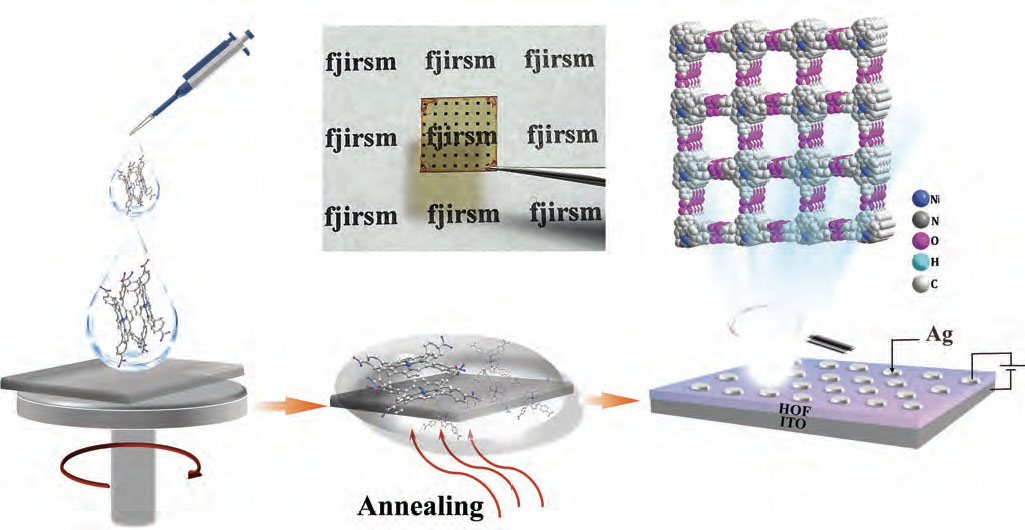| Oct 27, 2023 | |
Organic nanofilms transform resistive memory and electronics |
|
| (Nanowerk Spotlight) Researchers have been keenly interested in leveraging the useful properties of crystalline nanoporous materials for electronic applications. Ordered frameworks such as metal-organic frameworks (MOFs), covalent organic frameworks (COFs), and hydrogen-bonded organic frameworks (HOFs) have highly periodic structures and tunable functionality. Their unique characteristics make them promising as active layers in devices like resistive memory, a type of computer memory that stores data by switching between different electrical resistance states. | |
| The periodic porous structure and modifiable pore environment of crystalline frameworks could contribute to exceptional improvements in the performance of resistive memory, which offers faster, higher-density memory storage compared to conventional hard drives. | |
| However, a key limitation for wider use of these materials in resistive memory and other electronics has been the inability to process them into the smooth, uniform thin films required for incorporation into devices. | |
| To overcome this barrier, scientists at the Fujian Institute of Research on the Structure of Matter in China have now demonstrated a controlled way to crystallize HOFs into nanofilms using liquid solutions. This solution-processing takes advantage of the reversible nature of the hydrogen bonds that hold HOFs together, enabling the materials to be dissolved and re-solidified with ease. | |
| The team presents their findings in Advanced Materials ("Solution-Processed Hydrogen-Bonded Organic Framework Nanofilms for High-Performance Resistive Memory Devices"). | |
 |
|
| Solution-processed fabrication of HOF thin films and the photographic image of a typical Ag/PFC-73/ITO resistance memory device. (Reprinted with permission by Wiley-VCH Verlag) | |
| The researchers utilized a solution made of specific HOF crystals called PFC-73 to fabricate films with optimized thickness, roughness, and crystal alignment. Testing showed the films had smooth surfaces, good conductivity and thermal stability up to 200 °C – properties essential for practical use in electronics. | |
| To demonstrate potential applications, the team incorporated the HOF films into experimental resistive memory devices that store data by switching between low and high electrical resistance states. | |
| The prototypes showed excellent performance including quick switching, data retention for over 16 hours, and the ability to withstand over 60 write/erase cycles. | |
| Importantly, the devices operated at low voltages and without an initial “forming” step commonly needed for resistive memories. | |
| According to the researchers, HOF films may enable reusable, repairable electronics. This is because damaged HOF films can easily be re-dissolved and recrystallized, allowing the materials to be recovered and re-fabricated into new devices, a capability most electronic materials lack. To test this, the team dissolved scratched films and remade them into functioning memory devices, confirming the recyclability potential. | |
| The customizable properties, low-cost fabrication, and regenerative abilities of HOFs make them well-suited for bringing enhanced performance, sustainability and functionality to electronics applications. While further development is still needed, this early research demonstrates solution-processing as a promising route to harnessing the advantages of HOFs and other crystalline nanoporous frameworks. | |
| More broadly, the ability to cost-effectively produce high-quality organic electronics could help enable the next generation of flexible, efficient and resilient devices. | |
 By
Michael
Berger
– Michael is author of three books by the Royal Society of Chemistry:
Nano-Society: Pushing the Boundaries of Technology,
Nanotechnology: The Future is Tiny, and
Nanoengineering: The Skills and Tools Making Technology Invisible
Copyright ©
Nanowerk LLC
By
Michael
Berger
– Michael is author of three books by the Royal Society of Chemistry:
Nano-Society: Pushing the Boundaries of Technology,
Nanotechnology: The Future is Tiny, and
Nanoengineering: The Skills and Tools Making Technology Invisible
Copyright ©
Nanowerk LLC
|
|
|
Become a Spotlight guest author! Join our large and growing group of guest contributors. Have you just published a scientific paper or have other exciting developments to share with the nanotechnology community? Here is how to publish on nanowerk.com. |
|
